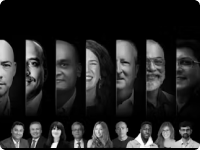Home > Resources > Newsletters > Retail Vue
8th August 2024
Oh, shoot! Fashion’s so much faster with AI
Excerpts from the masterclass on the patented personalization feature (USA, 2019) of the Vue.ai platform.
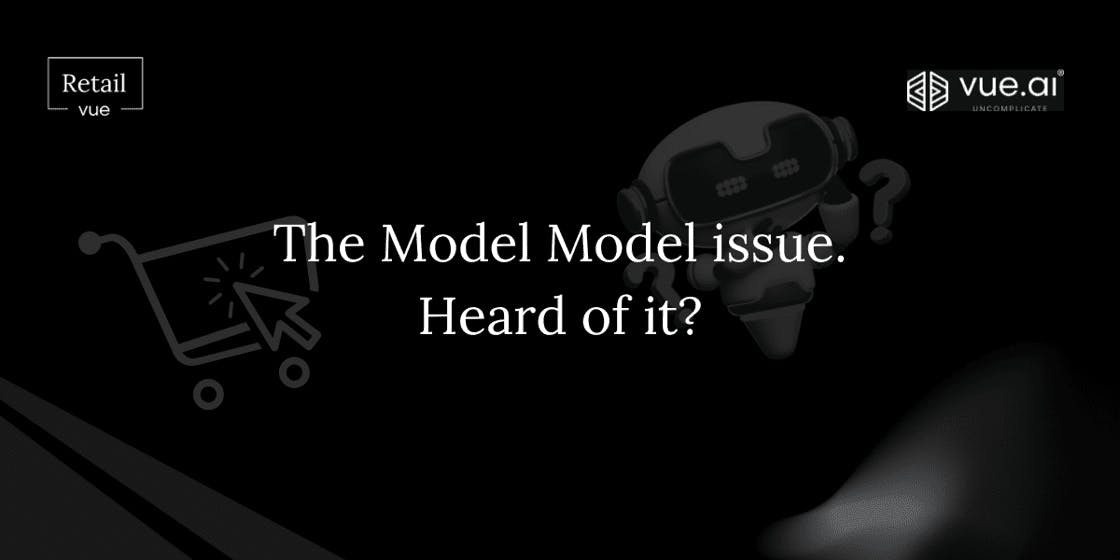
Alexander McQueen’s Spring / Summer ‘99 show where robots paint-sprayed models with washes of neon and Nicolas Ghesquière’s choice of “Lightning” – a digital avatar – as the surprise choice at Louis Vuitton’s Spring / Summer ‘16 campaign are but only a handful of outliers in an industry that has for long been ambivalent about technology. Fearing the loss of exclusivity, prestige and the immersive power of in-store experiences, fashion has been slow to adopt eCommerce and social media. And boy, how far the apple has fallen from there!
The engines that fuel AI today also power a variety of applications in the fashion industry, from trend forecasting to social welfare in supply chains. As for personalization… The term “democrasizing” coined by the global trend predictor WGSN aptly captures the latent demand for personalized sizing options that go beyond small to large, female to male.
A brisk and bold commentary on AI in fashion
VueModel, the patented (USA, 2019) personalization feature of the Vue.ai platform that’s of particular interest to fashion brands and retailers, was the subject of a recent Masterclass exposition to a select audience. Excerpts from the session hosted by Brian Harris, Director, R&D – New Initiatives & Digital Transformation, Vue.ai.
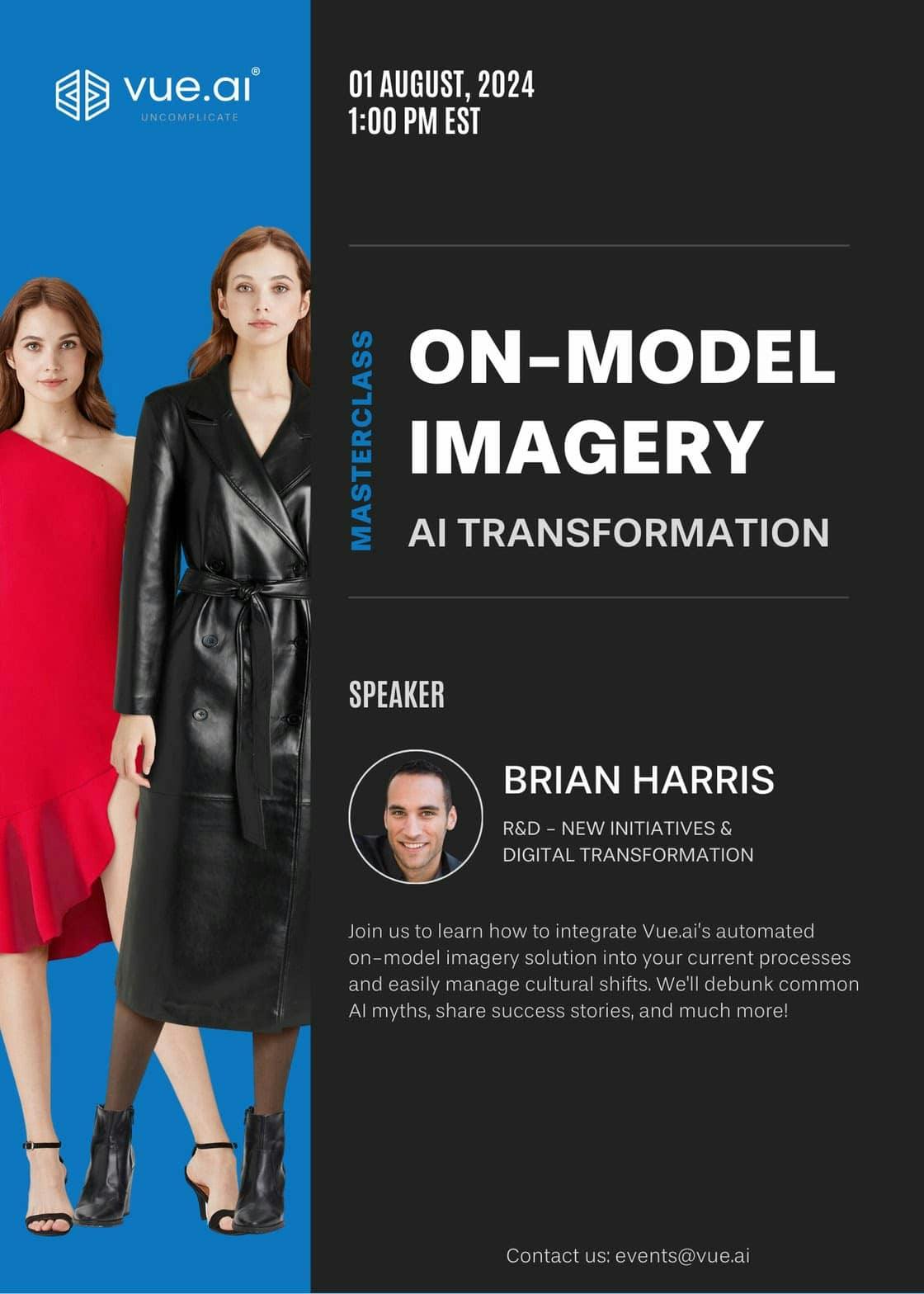
Convergence of AI and fashion
The lines between AI and fashion are blurring, with both fields advancing rapidly together. Notably, 62% of Generative AI users in marketing are creating image assets; 71% of them expect to eliminate “busy work” and focus on “strategic work”, through Gen AI.
The human element in fashion
Fashion is a powerful medium for human expression, reflecting who we are and what we believe. Authentic representation remains crucial, as demonstrated by the 22 - 54% returns attributed to “not as portrayed” by images and the 15% baseline increase in sales when using enhanced imagery.
The digital transformation strategy
Successful digital transformation involves understanding technology, identifying opportunities, engaging experts, and developing a supportive plan. While change can be challenging, it's essential for progress.
“Teams often find ways to overcome obstacles. When exploring new technology, focus on what you can achieve within that space instead of dismissing it outright. Be aware that too many variables can skew test results, leading to misleading conclusions. The first step is to identify where the technology can be effectively applied. Use this time as an opportunity for growth by involving more teams, such as studio and marketing, in a paid proof of concept. This approach not only tests the technology but also enhances data quality. “ - Brian Harris
Creative focus and production efficiency
AI enables creative professionals to focus on editorial and innovative work by handling routine production tasks. It helps overcome barriers such as time, cost, logistics, and studio space limitations, allowing photographers to concentrate on the pursuit of creativity.
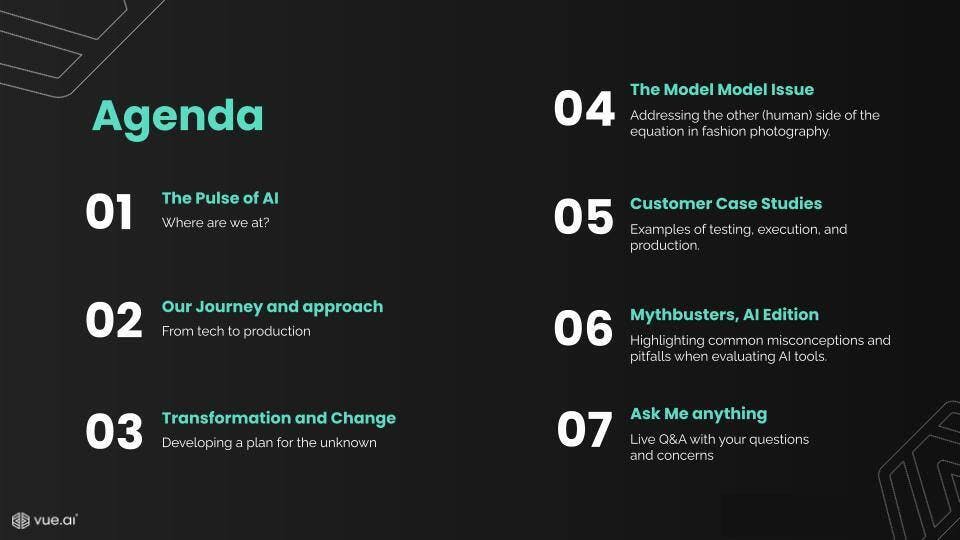
Navigating the Model Model issue
All AI algorithms use data, including images. At times, the programs use images to create new images: The new images then contain a piece of the data that helped create them, including the features and likenesses of the people involved, whether or not they consented to this usage.
Vue.ai adheres to ethical and equitable practices by compensating human models for their participation in the creation of input images, via a licensing agreement akin to traditional photography. This can involve either a small per-image fee or a larger yearly buyout for the images created using AI.
Misconceptions and realities of AI
AI is not a silver bullet and requires thoughtful application. It is important to identify meaningful impact and work towards solving specific problems rather than generalizing AI capabilities. Moreover, using AI does not mean giving away valuable brand data, as proper safeguards can ensure exclusivity.
Efficiency and innovation
Adopting new technologies like AI can initially be slow but lead to significant efficiency gains. For example, by optimizing iteratively for processes, equipment and the photo shoot team’s availability, a particular brand was able to reduce their photo shoot time from 6.5 hours to 40 minutes.
Ethical considerations in AI and human model use
Ethical systems fairly compensate human models for their participation and safeguard data exclusivity. Creatives maintain full control over how AI-generated images are created and used, ensuring ethical standards are upheld while reducing costs.
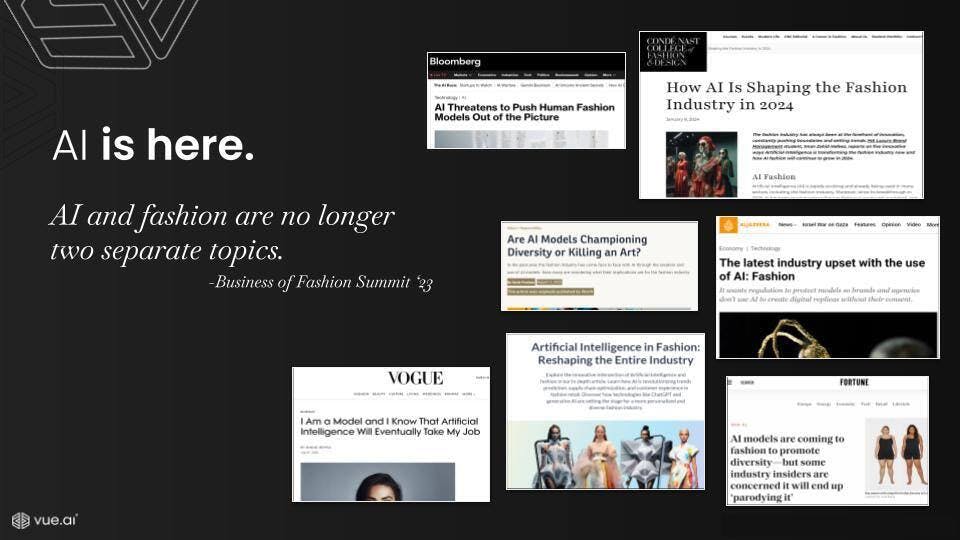
What’s a Masterclass without a Q & A?
What is the biggest ROI on investing in an AI model eCommerce solution?
While the ROI varies depending on the specific needs and goals of each brand, it’s pertinent to bear McKinsey’s position that within the next three years, any technology, media, and telecommunications space not connected to AI may be considered obsolete or ineffective.
How can Vue.ai help in viewing products on human models of different sizes and skin tones?
Yes, to achieve this, it's beneficial to use diverse data sources, including website assets and regional and shopper data, which can enhance the algorithmic model's accuracy and customization capabilities, to create on-model images of diverse human models.
How should I photograph a product to ensure it works well with a Generative AI model?
Ensure the product is photographed in a well-lit, aesthetically pleasing, and clean setting. The images should clearly represent the product, allowing the AI’s algorithms to accurately learn and apply the model for virtual try-ons.
Will the shots be unique to our brand if we use the AI model or you use the same AI model that's used for other models, or see it on competitors’ websites?
The AI-generated images will be unique to your brand. The models created are exclusive and not shared with other brands, ensuring there is no risk of data overlap or "data bleed." You can be confident that your content remains distinct and secure with us.
Coming up on the hour
Pioneering work early in the game (Virtual Try-On since 2016 with 4K cameras in 2019; US patent in 2019) has allowed Vue.ai to master on-model imagery and further, deploy its Virtual Try-on tech at about half a dozen fashion brands and retailers like Lane Crawford, Picard and Showpo. On clothing, for both men and women. On even non apparel categories such as bags, sunglasses and accessories. Read more about it here.
Over the next three to five years, Generative AI is poised to boost profits in the apparel, fashion and luxury sectors to the tune of USD 150B to 270B (MicKinsey). Immense opportunities for disruptive innovation are opening up for business and technology leaders. Write us an email to discuss your journey.
Boost conversions by 65%; AOV by 12%. Reduce product returns by 22%: For over three years now, Vue.ai has deployed the virtual Try-on tech at about half a dozen fashion brands and retailers. Hear Johanna Jankowski, eCommerce manager, Picard attest to the tech’s versatility both as a revenue generator and product returns reducer.
Five transformative shifts shaping today's retail world: From the pandemic's influence on shopper behaviour to Gen Z's rising power, sustainability focus and the imperative for AI integration, discover how retailers are adapting to meet evolving consumer demands.
AI roadblocks stressing you? Share the challenges; we’ll tech-tackle them.
